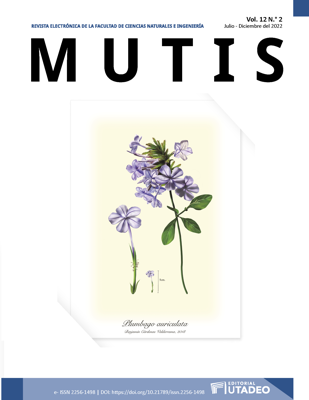
Esta obra está bajo una licencia internacional Creative Commons Atribución-NoComercial-CompartirIgual 4.0.
Esta obra está bajo una licencia internacional Creative Commons Atribución-NoComercial-CompartirIgual 4.0.
Resumen
This study was conducted to obtain semi-empirical mathematical models that represent the convective drying kinetics of squash epicarp at different temperatures (55, 65 and 75°C/10% RH/ drying speed 1ms-1). The best drying condition was selected to obtain flour, which was then characterized and used for the preparation of gluten-free bread. Subsequently, the effect of incorporating squash epicarp flour (SEF) into 4 levels (0-control, 15, 20 and 25g / 100 g of flour) on the sensory acceptance of the bread was evaluated. The results of this study are that the two-term model best describes the curve obtained at 55 °C, and the logarithmic model best describes the curves obtained at 65 °C and 75 °C. The temperature of 65 °C was selected as the best drying condition. Finally, the highest acceptance and purchase intention was obtained from the bread produced with 15 g SEF / 100 g of flour.
Citas
American Association of Cereal Chemists. (2001). AACC 08-01: Ash -basic method , Paul, MN, USA.
Amini Khoozani, A., Kebede, B., & El-Din Ahmed Bekhit, A. (2020). Rheological, textural and structural changes in dough and bread partially substituted with whole green banana flour. LWT, 126, 109252. https://doi.org/10.1016/j.lwt.2020.109252
Arendt, E. K. , O’brien, C. M., Gormley, T. R., & Ronan, T. (2002). Development of Gluten-Free Cereal Products. Repository UCD. http://hdl.handle.net/10197/6892
Arslan, M., Rakha, A., Xiaobo, Z., & Mahmood, M. A. (2019). Complimenting gluten free bakery products with dietary fiber: Opportunities and constraints. Trends in Food Science & Technology, 83, 194–202. https://doi.org/10.1016/J.TIFS.2018.11.011
Aziah, A. A. N., Ho, L. H., Komathi, C. A., & Bhat, R. (2011). Evaluation of Resistant Starch in Crackers Incorporated with Unpeeled and Peeled Pumpkin Flour. American Journal of Food Technology, 6(12), 1054–1060. https://doi.org/10.3923/ajft.2011.1054.1060
Bas-Bellver, C., Barrera, C., Betoret, N., & Seguí, L. (2020). Turning Agri-Food Cooperative Vegetable Residues into Functional Powdered Ingredients for the Food Industry. Sustainability, 12(4), 1284. https://doi.org/10.3390/su12041284
Bemfeito, C. M., Carneiro, J. de D. S., Carvalho, E. E. N., Coli, P. C., Pereira, R. C., & Vilas Boas, E. V. de B. (2020). Nutritional and functional potential of pumpkin (Cucurbita moschata) pulp and pequi (Caryocar brasiliense Camb.) peel flours. Journal of Food Science and Technology, 57(10), 3920–3925. https://doi.org/10.1007/S13197-020-04590-4
Carolina, A., Staichok, B., Rayssa, K., Mendonça, B., Guerra, P., Santos, A. dos, Gonçalves, L., Garcia, C., & Damiani, C. (2016). Pumpkin Peel Flour (Cucurbita máxima L.)-Characterization and Technological Applicability. Journal of Food and Nutrition Research, 4(5), 327–333. https://doi.org/10.12691/jfnr-4-5-9
Coronel, E. B., Guiotto, E. N., Aspiroz, M. C., Tomás, M. C., Nolasco, S. M., & Capitani, M. I. (2021). Development of gluten-free premixes with buckwheat and chia flours: Application in a bread product. LWT, 141, 110916. https://doi.org/10.1016/j.lwt.2021.110916
Crank, J. (1975). The Mathematics of Diffusion. Oxford University, 2nd ed., Vol. 1.
Decock, P., & Cappelle, S. (2005). Bread technology and sourdough technology. Trends in Food Science & Technology, 16(1–3), 113–120. https://doi.org/10.1016/J.TIFS.2004.04.012
Food and Agriculture Organization of the United Nations - FAO. (2021). ODS 12. Producción y consumo responsables | Objetivos de Desarrollo Sostenible | Organización de las Naciones Unidas para la Agricultura y la Alimentación. https://www.fao.org/sustainable-development-goals/goals/goal-12/en/
Food and Agriculture Organization of the United Nations - FAO. (2014). FAOSTAT. https://www.fao.org/faostat/en/#data/QC
Franco, V. A., García, L. G. C., & Silva, F. A. da. (2020). Addition of hydrocolidics in gluten-free bread and replacement of rice flour for sweet potato flour. Food Science and Technology, 40(suppl 1), 88–96. https://doi.org/10.1590/fst.05919
Geankoplis, C. J. (2006). Procesos de transporte y principios de procesos de separación (incluye operaciones unitarias). Compañía Editorial Continental CECSA. 4th Edición.
Guiné, R. P. F., Henrriques, F., & João Barroca, M. (2012). Mass Transfer Coefficients for the Drying of Pumpkin (Cucurbita moschata) and Dried Product Quality. Food and Bioprocess Technology, 5(1), 176–183. https://doi.org/10.1007/s11947-009-0275-y
Gustavsson, J., Cederberg, C., Sonesson, U., van Otterdijk, R. & Meybeck, A. (2011). Pérdidas y Desperdicio de Alimentos en el Mundo – Alcance, Causas y Prevención. Organización de las Naciones Unidas para la alimentación y la agricultura. https://www.fao.org/sustainable-food-value-chains/library/detalles/es/c/278445/
International Organization for Standardization - ISO. (2009). ISO 1871 determination of nitrogen by the Kjeldahl method, Geneva.
Jalali, M., Sheikholeslami, Z., Elhamirad, A. H., Haddad Khodaparast, M. H., & Karimi, M. (2020). The effect of the ultrasound process and pre-gelatinization of the corn flour on the textural, visual, and sensory properties in gluten-free pan bread. Journal of Food Science and Technology, 57(3), 993–1002. https://doi.org/10.1007/s13197-019-04132-7
Joardder, M. U. H., Alsbua, R., Akram, W., & Karim, M. A. (2020). Effect of sample rugged surface on energy consumption and quality of plant-based food materials in convective drying. Drying Technology 39(10), 1339–1348. https://doi.org/10.1080/07373937.2020.1745824
Kim, M. Y., Kim, E. J., Kim, Y.-N., Choi, C., & Lee, B.-H. (2012). Comparison of the chemical compositions and nutritive values of various pumpkin ( Cucurbitaceae ) species and parts. Nutrition Research and Practice, 6(1), 21. https://doi.org/10.4162/nrp.2012.6.1.21
Kulczynski, B., & Gramza-Michałowska, A. (2019). The Profile of Carotenoids and Other Bioactive Molecules in Various Pumpkin Fruits (Cucurbita maxima Duchesne) Cultivars. Molecules, 24(18), 3212. https://doi.org/10.3390/MOLECULES24183212
Lima, P. M., Dacanal, G. C., Pinho, L. S., Pérez-Córdoba, L. J., Thomazini, M., Moraes, I. C. F., & Favaro-Trindade, C. S. (2021). Production of a rich-carotenoid colorant from pumpkin peels using oil-in-water emulsion followed by spray drying. Food Research International, 148, 110627. https://doi.org/10.1016/J.FOODRES.2021.110627
López-Mejía, N., & Morales Posada, N. B. (2020). Optimización de la formulación de tallarines libres de gluten enriquecidos con pulpa de zapallo deshidratada empleando el método de diseño de mezclas. Brazilian Journal of Food Technology, 23. https://doi.org/10.1590/1981-6723.29918
Mala, K. S., & Kurian, A. E. (2016). Nutritional composition and antioxidant activity of pumpkin wastes international journal of pharmaceutical, chemical and biological sciences nutritional composition and antioxidant activity of pumpkin wastes. Research Journal of Pharmaceutical, Biological and Chemical Sciences 6(3), 336-34
Marín B, E., Lemus M, R., Flores M, V., & Vega G, A. (2006). la rehidratación de alimentos deshidratados. Revista Chilena de Nutrición, 33(3). https://doi.org/10.4067/S0717-75182006000500009
McCleary, B. v., DeVries, J. W., Rader, J. I., Cohen, G., Prosky, L., Mugford, D. C., Champ, M., & Okuma, K. (2012). Determination of insoluble, soluble, and total dietary fiber (CODEX definition) by enzymatic-gravimetric method and liquid chromatography: Collaborative study. Journal of AOAC International, 95(3), 824–844. https://doi.org/10.5740/jaoacint.CS2011_25
Murray, J. A. (1999). The widening spectrum of celiac disease. The American Journal of Clinical Nutrition, 69(3), 354–365. https://doi.org/10.1093/AJCN/69.3.354
Nakilcioğlu-Taş, E., Coşan, G., & Ötleş, S. (2021). Optimization of process conditions to improve the quality properties of healthy watermelon snacks developed by hot-air drying. Journal of Food Measurement and Characterization, 15(2), 2146–2160. https://doi.org/10.1007/S11694-020-00808-3
Nasir, S., Allai, F. M., Gani, M., Ganaie, S., Gul, K., Jabeen, A., & Majeed, D. (2020). Physical, Textural, Rheological, and Sensory Characteristics of Amaranth-Based Wheat Flour Bread. International Journal of Food Science, 2020, 1–9. https://doi.org/10.1155/2020/8874872
O’Shea, N., Arendt, E. K., & Gallagher, E. (2012). Dietary fibre and phytochemical characteristics of fruit and vegetable by-products and their recent applications as novel ingredients in food products. Innovative Food Science & Emerging Technologies, 16, 1–10. https://doi.org/10.1016/J.IFSET.2012.06.002
Park, Y. W. (1987). Effect of Freezing, Thawing, Drying, and Cooking on Carotene Retention in Carrots, Broccoli and Spinach. Journal of Food Science, 52(4), 1022–1025. https://doi.org/10.1111/j.1365-2621.1987.tb14266.x
Puente-Díaz, L., Ah-Hen, K., Vega-Gálvez, A., Lemus-Mondaca, R., & Scala, K. di. (2013). Combined Infrared-Convective Drying of Murta (Ugni molinae Turcz) Berries: Kinetic Modeling and Quality Assessment. Drying Technology, 31(3), 329–338. https://doi.org/10.1080/07373937.2012.736113
Salami, A., Asefi, N., Kenari, R. E., & Gharekhani, M. (2021). Extraction of pumpkin peel extract using supercritical CO2 and subcritical water technology: Enhancing oxidative stability of canola oil. Journal of Food Science and Technology, 58(3), 1101–1109. https://doi.org/10.1007/S13197-020-04624-X/TABLES/5
Song, J., Wei, Q., Wang, X., Li, D., Liu, C., Zhang, M., & Meng, L. (2018). Degradation of carotenoids in dehydrated pumpkins as affected by different storage conditions. Food Research International, 107, 130–136. https://doi.org/10.1016/J.FOODRES.2018.02.024
Toor, R. K., & Savage, G. P. (2006). Effect of semi-drying on the antioxidant components of tomatoes. Food Chemistry, 94(1), 90–97. https://doi.org/10.1016/j.foodchem.2004.10.054
Vázquez-Chávez, L., & Vizcarra-Mendoza, M. (2008). Secado por lecho fluidizado del trigo y su calidad. Revista Mexicana de Ingeniería Química, 7(2), 131–137. http://rmiq.org/ojs311/index.php/rmiq/article/view/1815
Wang, X., Lao, X., Bao, Y., Guan, X., & Li, C. (2021). Effect of whole quinoa flour substitution on the texture and in vitro starch digestibility of wheat bread. Food Hydrocolloids, 119, 106840. https://doi.org/10.1016/j.foodhyd.2021.106840
Xia, B., & Sun, D.-W. (2002). Applications of computational fluid dynamics (CFD) in the food industry: a review. Computers and Electronics in Agriculture, 34(1–3), 5–24. https://doi.org/10.1016/S0168-1699(01)00177-6
Yadav, M., Jain, S., Tomar, R., Prasad, G. B. K. S., & Yadav, H. (2010). Medicinal and biological potential of pumpkin: an updated review. Nutrition Research Reviews, 23(2), 184–190. https://doi.org/10.1017/S0954422410000107
Zhou, Y., Dhital, S., Zhao, C., Ye, F., Chen, J., & Zhao, G. (2021). Dietary fiber-gluten protein interaction in wheat flour dough: Analysis, consequences and proposed mechanisms. Food Hydrocolloids, 111, 106203. https://doi.org/10.1016/J.FOODHYD.2020.106203
Descargas
Datos de publicación
Perfil evaluadores/as N/D
Declaraciones de autoría
- Sociedad académica
- Universidad de Bogotá Jorge Tadeo Lozano
- Editorial
- Universidad de Bogotá Jorge Tadeo Lozano

 PDF (English)
PDF (English)
 FLIP
FLIP













